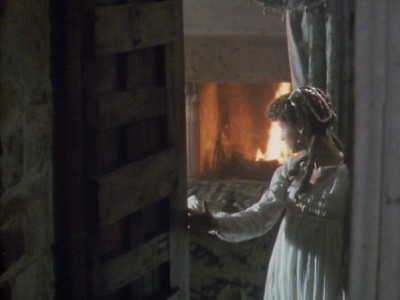A Paper Delivered at the Eastern Region meeting of the American Society for Eighteenth Century Studies conference
Georgetown University, November 6-9, 2008. "Re-evaluating Austen." Chairperson: Elizabeth Lambert. Panelists: Elizabeth Lambert, "Raising Demons: Children in Austen's Novels;" Manuel Schonhorn, "Sites of Value in Mansfield Park;" Ellen Moody, "The Gothic Northanger Abbey." I publish the paper on this website to make the paper widely available, complete with scholarly notes.The Gothic Northanger Abbey: A Re-evaluation
by Ellen Moody
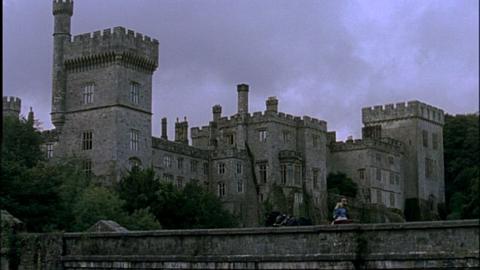
It is the purpose of this talk to show that notwithstanding Austen's insistence on the unromantic nature of experience in Catherine (her title for the book), she does not replace the "visions of romance" (II:10, 187) with "the anxieties of common life" (189); rather she uses these visions to offer an optimistic take on the painful experience of growing up female1. Alluringly picturesque and gothic motifs are thoroughly integrated into Austen's book; like Ann Radcliffe's heroines, Austen's Catherine re-enacts a patient wary form of the Psyche paradigm to become an important individual in a happy social community2.
In this view I differ from three common approaches to the novel. There are those who just barely tolerate the seven chapters of explicit gothic adventure at Northanger Abbey (II:3-II:10), conceding the passages belong to Austen's examination of fiction and the imagination. These chapters are regarded as juvenilia or a later add-on; the novel treated as light or not quite mature3. Then there are are those who argue "Northanger Abbey does not refute, but rather clarifies and reclaims gothic conventions ... as "a subversive critique of patriarchy. The tendency has been to see gothic itself as masochistic and re-creations such as Austen's pessimistic. A Walton Litz says of this book: Jane Austen might have said, with Henry James, I have the imagination of disaster -- and see life as ferocious and sinister. Such critics value its passages and characters of strong emotional violence kept just under control, and show that it went through at least three revisions4. A third group find the book to be brilliantly witty, filled to the brim with ghosts of the gothic, skeins of allusion, and self-reflexive discourses on, for example, contemporary politics, architecture, and history; gothic plays, womens' novels, and fantasy5.
Well, did Henry Austen rightly retitle his sister's book Northanger Abbey? I think so: but I also think the book is all of a piece6 and a gothic which empowers women. I begin with the text. Wit and parodic utterances are found throughout the overtly gothic chapters at Northanger; romance, sentiment, and gothicism, in the opening, Bath, and closing journey sequences. Austen's repeated ploy is first to deny an asserted heightened emotionalism, then assert in an understated way a strong emotional response, and then dramatize a painful experience visible to the perceptive. For example, at a Bath assembly Catherine sees Henry Tilney with his sister for the first time, and "immediately guesses it is his sister," so, as the narrator says, "instead of turning a deathlike paleness, and falling in a fit on Mrs Allen's bosom, Catherine sat erect, in the perfect use of her senses, and with cheeks only a little redder than usual" (52). The phrase "a little redder than usual" is in context a really felt reaction. When Catherine found herself a wallflower, stood up by John Thorpe and deserted by her supposed friend, Isabella, we were told "To be disgraced in the eye of the world, to wear the appearance of infamy while her heart is all purity, her actions all innocence, and the misconduct of another the true source of her debasement, is one of those circumstances which peculiarly belong to the heroine's life ...[I skip a little] ... Catherine had fortitude too; she suffered, but no murmur passed her lips." She is also "humiliated" and "aroused" (I:8, 52) first to feel shame and then to blush.
Throughout Northanger Abbey, Austen exploits exaggeration while insisting on the reality and importance of sensitive feeling. In the book's concluding chapters, the oscillations pile up rapidly. The comedy of Mrs Morland's attempt to cheer Catherine's "depression" with "a very clever Essay" contextualizes this sentence: "In her rambling and her idleness [Catherine] might only be a caricature of herself; but in her silence and sadness she was the very reverse of all that she had been before," followed by this sentence: "he remained for some minutes most civilly answering all Mrs. Morland's common remarks about the weather and roads. Catherine meanwhile -- the anxious, agitated, happy, feverish Catherine -- said not a word" (II:15 [30], 226). And now the deflation: "though Henry was now sincerely attached to her ...[I skip a little] ... I must confess that his affection originated in nothing better than gratitude (227). "Nothing better than" is another reverse understatement: Northanger Abbey has demonstrated that gratitude is rare and precious, especially when acted upon.
A fluctuating sparkling wand plays over this text's gothic picturesque. As Catherine and Henry draw near the abbey, we are told Catherine's "impatience" "returned in full force:" "and every bend in the road was expected with solemn awe to afford a glimpse of its massy walls of grey stone, rising amidst a grove of ancient oaks, with the last beams of the sun playing in beautiful splendour on its high Gothic windows" (II:5 [20], 152), only to find "the breeze had not seemed to waft the sighs of the murdered to her" and "so low did the building stand, that she found herself passing through the great gates of the lodge into the very grounds of Northanger, without having discerned even an antique chimney" where the breeze wafts "nothing worse than a mizzling rain," after which though (on the next day) Austen again reverses positions: [Catherine] was struck, however, beyond her expectation, by the grandeur of the abbey, as she saw it for the first time from the lawn. The whole building enclosed a large court; and two sides of the quadrangle, rich in Gothic ornaments, stood forward for admiration. The remainder was shut off by knolls of old trees, or luxuriant plantations, and the steep woody hills rising behind, to give it shelter, were beautiful even in the leafless month of March. Catherine had seen nothing to compare with it ..." (II:7 [22], 168)7
The mode is parody combined with intensified cliches either preceded or followed by a character's experience of understated but passionate inward feeling. For some readers this continual alternation of sentiment and irony is experienced as an obstacle to a desired suspension of disbelief. They want either parodic derision of intangible feelings, or unqualified immersion in unexpected hurts, anxiety, betrayals, bullying, distress, and remorse. Austen will not allow us to choose.
At the same time, Austen's book is a sanguine gothic with an assured faith in female friendship and loving mothers, even in an environment shaped by male hegemony and primogeniture. We experience the power of law and customs which even encourage putting hard and exploitative people into positions of almost complete economic and social power over others (especially older men over their wives, daughters, and younger sons). Northanger Abbey fits the description of female gothic presented in Anne Williamss The Art of Darkness, where Williams argues such loaded situations can affirm the power of the heroine to uncover what has been hidden from view, a past of injustice and emotional pain. Within the codes of her culture, the heroine in the typical, satisfying and most popular female gothics achieves a strong social identity. Such texts are melancholy but not tragic, idealistic in thrust, and occupy a terrain structured not by an Oedipal but a Psyche paradigm in which Psyche emerges victorious. At the center of such stories we experience a young girl defy repeated prohibitions against adventure: the great commonplace is the heroine who rises from her bed in the dark with a candle and takes labyrinthian flights of stairs to reach a place associated with an absent mother8. This sequence is repeated several times in the two costume drama Northanger films9. First 32 seconds from Andrew Davies' 2007 version [in lieu of a clip, I provide stills and a transcript of the lines].
We first see Catherine Morland (Felicity Jones) and Eleanor Tilney (Catherine Walker) walking in Eleanor's mother's favorite grove.
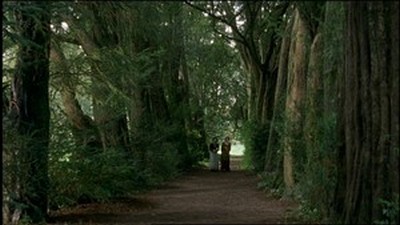
As in Austen's book, Davies' Eleanor tells his Catherine this was "my mother's favorite place," and she and her mother would walk there. Her mother's death has been "a great and increasing affliction" to her, "though I never loved it then as I have loved it since." Catherine then asks how Mrs Tilney died, and curious (like Psyche) to see if Eleanor looks like her mother, is eager to see a picture hanging in the mother's chamber. Davies adds Eleanor's demur ("We never go there. It is my father's wish"), Catherine's eager protest ("But to see her picture?"), and Eleanor's sudden resolution: "Yes, why should you not see it?"
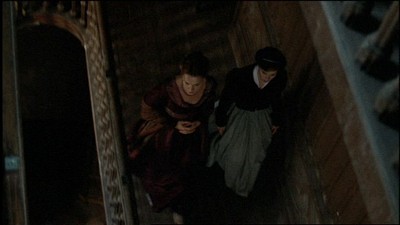
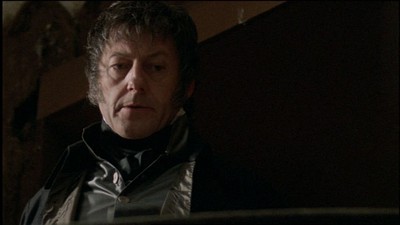
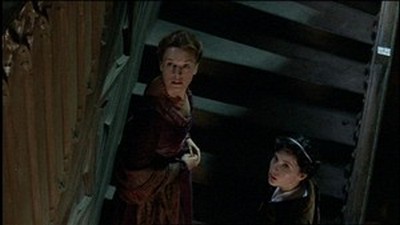
The general's word: "What do you there? ... There is nothing to interest Miss Morland in this part of the house. I am surprized at you, Eleanor."
They are thwarted, but the second time, as in Austen's book, Davies' Catherine is not and makes her way into Mrs Tilney's room. What is usually stressed in discussions of Austen's book is Henry's startled and rebarbative reaction. But this is one moment in a narrative which next awards Catherine with Henry's welcoming her to their future comfortable home, and, ultimately, after her ejection from the Abbey, Henry's decision to defy his father and follow her back to Fullerton, ask her to marry him, and then tell her enough of his father that Catherine feels "that, in suspecting General Tilney of either murdering or shutting up his wife, she had scarcely sinned against his character, or magnified his cruelty" (2:15 [30], 230). Catherine is vindicated.
The female gothic typically includes a good kindly (often semi-brotherly) helper male type, who undergoes an education partly through the young woman's trials; the older tyrannical domineering male who unnerves the heroine and controls her movements; a predatory younger male, and a secondary immured heroine, often older, a mother or aunt who befriends the heroine10. Matthew Francis's 1997 effective stage play, Northanger Abbey, reveals how Austen intersects this typology: scenes from Radcliffes Udolpho alternate with scenes from Northanger, and the same actors play, respectively, the Catherine and Emily parts, the Henry Tilney and Valancourt parts, General Tilney and Montoni, Mrs Morland and Eleanor Tilney (so the sister-friend of Austen's novel becomes a sister-mother-friend), Mrs Allen and Annette (the chaperone becomes the maid-companion)11.
The felt ferocity of Austen's General has often been remarked upon; it is not emphasized how our memory of him is shaped by his treatment of his daughter. In Austen's book there are many sentences suggesting how unhappy and tyrannized over Eleanor Tilney has been, none more "distressing" (Catherine's word) than those with which Eleanor tells Catherine she dare not attempt to keep Catherine at Northanger past the following dawn. Henry tells Catherine he is grateful to her for visiting Northanger because of his sister's usual isolation and suffering. When Austen dismisses Eleanor to happiness at the book's close amid the self-reflexive amusement and witty plays on romantic conventions is this unfunny sentence: the narrator knows "no one" "better prepared by habitual suffering, to receive and enjoy felicity" (II:16 [31], 234). In both films the actors (in the 2007 film, Liam Cunningham) convey a threat of some unspeakable sexual punishment he is prepared to wreak on Eleanor.
Another 15 seconds from the 2007 Northanger Abbey [again I provide stills; there is no dialogue only unnerving minor key music]. When in a violent rage, General Tilney comes back to Northanger Abbey, we hear him shouting at Eleanor. After Eleanor's conference with Catherine in Catherine's room, we watch a terrified Eleanor in white walk upstairs to this man and Catherine flee. (It is a wordless scene accompanied by unnerving music.)
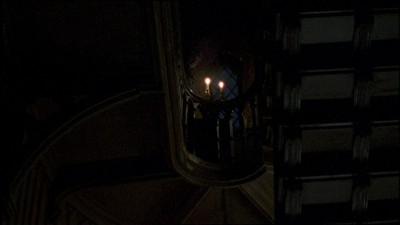
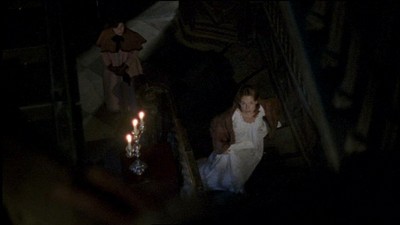
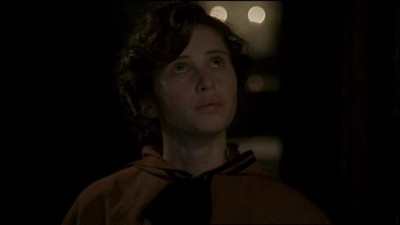
In Sedgwick's The Coherence of Gothic Conventions she observes that astonishingly from the earliest books we recognize as gothic, all the gothic conventions all occur together, at once, and as if formed from a long held tradition12. But it is not true that everyone immediately understands how the conventions function, nor does Sedgwick include them all: she omits the picturesque, the mother-daughter pair, female alliances, and the happy interlude. These are found in all three Northanger Abbey films13 which read the book more or less as female gothic.
The costume dramas allegorize and visually recreate Austen's gothic picturesque; the free adaptation, Victor Nunez's Ruby in Paradise updates the feminism of her book14. Maggie Wadey's 87 film is picturesque, and filled with thoughtful conversations taken from Austen's book while Davies appeals to us through the capital way the two principals, Felicity Jones and J. J. Feild (as Henry Tilney), jell as a pair of characters whose mutual kindness, intelligence, and integrity of heart emerges gradually as very precious indeed against the film's "crimes of heart." Very like Amy Heckerling's Clueless, Victor Nunez's Ruby in Paradise is an updated "young lady's entrance into world"15.
I turn to the uses of picture in the 87 Northanger Abbey. Wadey's film reproduces, extends, and simplifies the conversation of Austen's Catherine, Henry, and Eleanor's walk on Beechen clifff. Henry (Peter Firth), Catherine (Katherine Schleisinger) and Eleanor (Ingrid Lacey) walk and talk of history, art, and nature
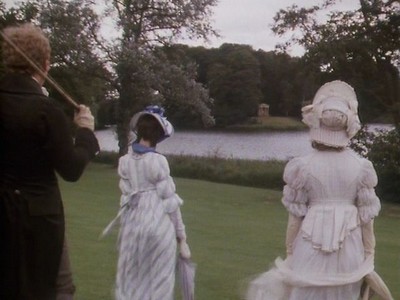
in front of Radcliffean waterfalls, amid green forests,
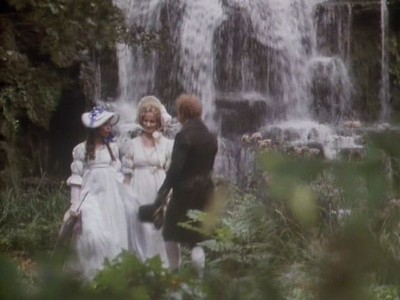
and in a boat on an oneiric lake.
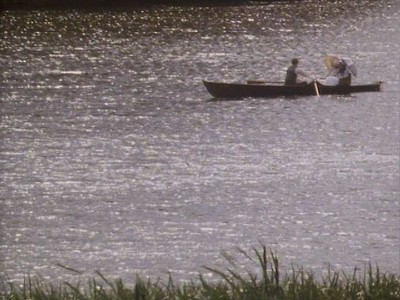
Intimacy and trust is established; non-diegetic music reinforces the interlude's harmony while, like Austen's, Wadey's Henry also slights women, discusses politics, and is put down by Wadey's Eleanor.
Spoken and paradigms of feminism mingle with the picturesque. Mrs Tilney's suffering is represented symbolically by statues found in gardens and Catherine's window; witch imagery visualizes the sublime indifference and gothic nervousness of two older female characters, Googie Withers as Mrs Allen, and Elaine Ives-Cameron as the General's mistress, a Marchioness whose husband has been guillotined. In this still, Mrs Tilney's presence as a statue warns Catherine not to go out riding and not to wear Mrs Tilney's riding outfit lest Catherine incur the same kinds of experience Mrs Tilney did:
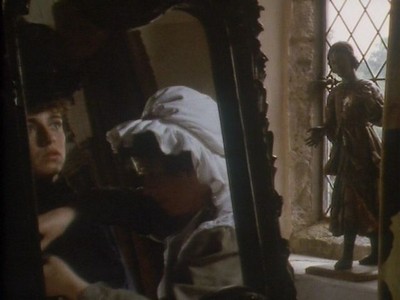
In Wadey's dramatization of Austen's playful conversation where Austen's Henry makes his analogy between a dance and marriage, Wadey's Catherine produces an argument against the analogy: once she is married to him a woman loses her right to refuse a man. This film dramatizes Henry's defiance of his scornful father, and then Henry's journey to Catherine as a return to film's opening picturesque scene15.
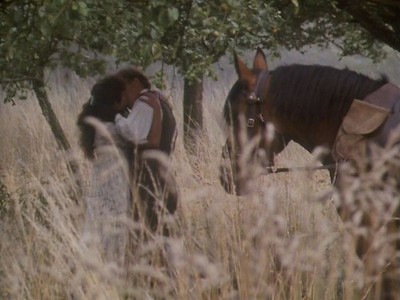
Davies mixes a development of the human relationships in Austen's book with gothic language. His Henry Tilney explains what the General did to Mrs Tilney as a brand of "vampirism" which "drained the life out of her." It is not uncommon for Davies to show sympathy for amoral unadmirable characters, and he does so here: for example, Davies' John Thorpe (William Beck) justifies his lies. But he also, most unusually, shows some sympathy for Isabella Thorpe (played by Carey Mulligan): we can pity her as she is rejected by Captain Tilney so cavalierly as another young woman experiencing a painful induction into the manipulations of the adult male world: Davies' Eleanor frames Isabella thus: "Your friend has dealt with your brother very badly, but I fear she is out of her depths with mine."
Davies exploits Feild's ability to project sensitive intelligence and emotional vulnerability
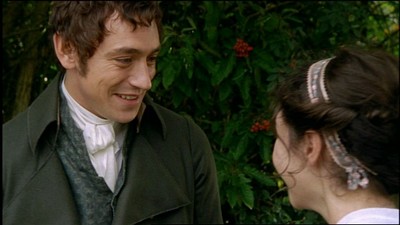
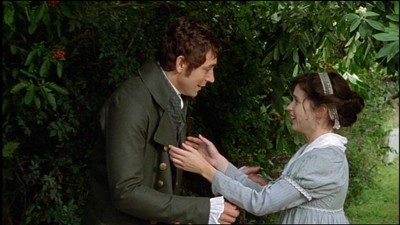
to make his gothic brotherly moral hero someone who seeks the heroine for her sincerity, belief in love and goodness, and consequent strength to help him protect his own hurt self.
Davies also emphasizes female friendship and includes a wholly original happy interlude. He first often replaces Henry with Eleanor; for example, the letter scenes late in the film give lines to Eleanor that Austen gave Henry.
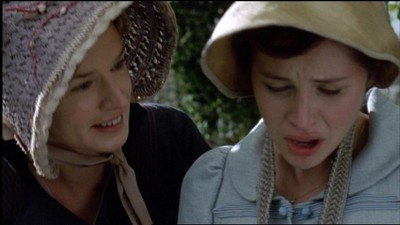
The changed emphasis becomes a triangle of sunlit supportive congenial companionship when the general leaves the Abbey. We see Henry get a ladder, climb a tree, and to the accompaniment of the bouncy cheerful music, Henry rains apples on the girls, and they run about to catch them in their skirts:
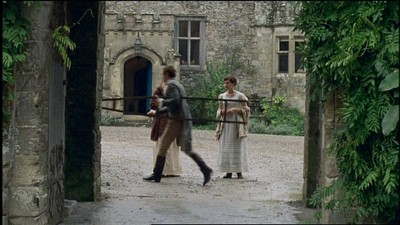
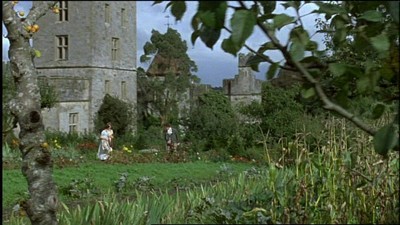
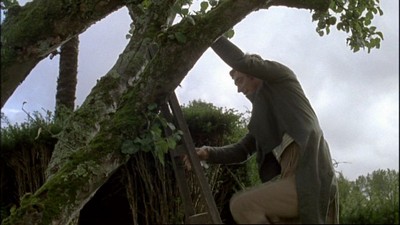
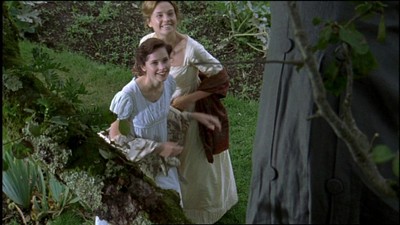
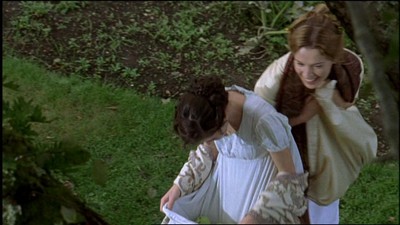
(It's another essentially wordless scene.) There is no sin here. As is common in female gothics and womens' films, this happy interlude is overshadowed: it cannot last.
Ruby in Paradise dramatizes a contemporary teenage heroine's struggle to discover who she is, and to make a good place for herself in a world that puts her at serious risk. Ruby Gissing (Ashley Judd) is our Catherine Morland character. As the movie begins, Ruby is leaving a young man (boyfriend, partner? it's not clear) and driving herself to Florida because her few good memories of her time with her family come from when they went to Florida on vacation. Ruby has to integrate herself into the community by getting a job; she is hired by Mildred Chambers (Dorothy Lyman) who owns a tourist souvenir and clothing store on the gulf coast of Florida.
A few feminist parallels. Mrs Chambers' sexy show-off lying boorish son, Ricky (Bentley Mitchum), combines characteristics of John Thorpe and Captain Tilney. He persuades Ruby to ignore his mother's prohibition against the staff going out with her rich son. When Ruby resists continuing to have sex with him, Ricky attempts to coerce her; enraged at her refusal, he fires her. In Richardson's epistolary novel, Pamela, a servant girl refuses to have sex with her boss, and he rewards her virtue by marrying her. Here we see the realistic results of such refusal. A montage of anxiety-producing hard scenes show us Ruby continuously refused jobs, sinking lower and lower, even considering topless dancing, and finally working as a laundress. Ruby is rescued by an African-American female friend, Rochelle (played by Allison Dean) who explains to Mrs Chambers what happened, and by Mrs Chamber's identification with Ruby. The climax of the film is a displaced mother-daughter scene, where Mildred tells Ruby she hired her because saw herself in Ruby.
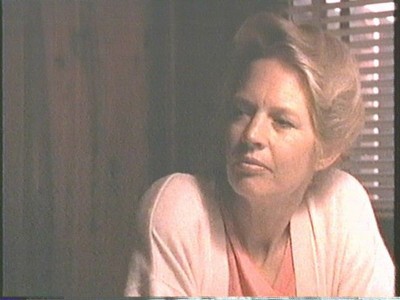
The film ends with Ruby opening the shop as its new assistant manager.
The movie shows the importance of female alliances and absent mothers and grandmothers. Mrs Chambers and Rochelle are Ruby's mentors. Rochelle functions like Eleanor Tilney in a number of the conversations, including one where she lends Ruby needed money. Like Austen's Catherine and Eleanor, Ruby and Rochelle eat together, attend dances, walk and share past memories, dreams and hopes.
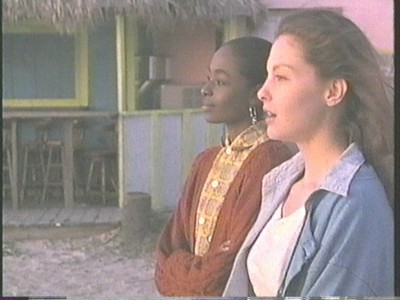
Ruby helps and is helped by Debrah Ann (Betsy Douds), a high-school drop-out dependent on the two young men she lives with. They occasionally beat her, and when Ruby lets Betsy stay the night in her apartment, Betsy sees Ruby's picture of Ruby's grandmother and says one of her problems is as a child she had no mother or grandmother to be with her.. Ruby is physically helped by the stronger older women who work at the laundromat, and cheered by a Southern Asian young woman who lives near Ruby and is presented as proud and contented to be doing menial housework as a member of a tightly-knit family of immigrants.
The film's feminism resembles that of other Austen movies. Like these, our heroine is repeatedly pictured and heard writing in a journal and (most unusually for films in general) we have a frequent use of a voiced-over female narrator.17
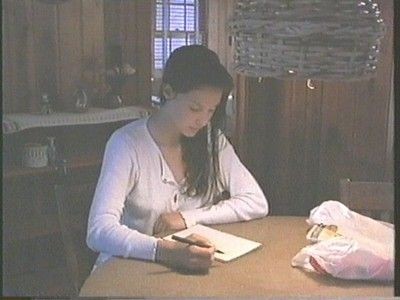
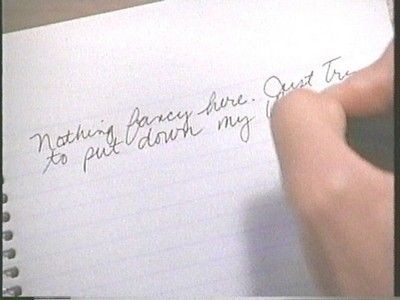
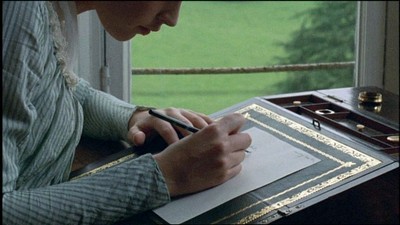
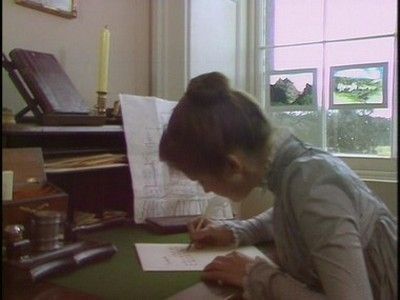
Its Northanger Abbey framework is signalled when Ruby stumbles upon a copy of Austen's book in her good boyfriend's considerable library. Mike McCaslin (played by Todd Field) updates Henry Tilney[18]: he lectures Ruby on environmentalism and the local landscape; he does not pressure Ruby for sex. When they discuss Austen, they compare Ruby's and Catherine Morland's characters, and he says Austen "restores" the soul" while she "reveals the contradictions and value system of an entire society. In this still, Ruby is saying that like Catherine, she's a heroine "against the odds19."
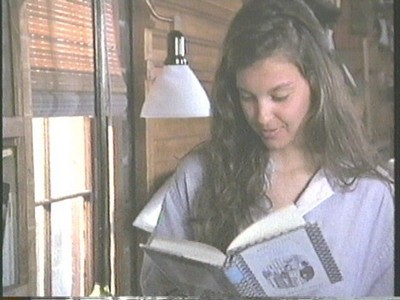
My re-evaluation of Austen's Northanger Abbey and discussion of its three film adaptations has, I hope, revealed the book to be a homogenous work of art and an instance of the female gothic20. I first read Northanger Abbey between the ages of 17 and 19, Radcliffe's Romance of the Forest around age 20, and I have read Mysteries of Udolpho at least three times. I am one of those viewers who is distressed when before Henry returns to Catherine, Wadey and Davies film copies of Udolpho burning.21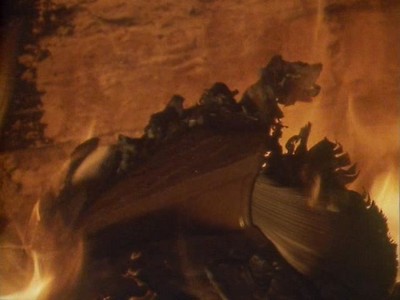
With Beatrice Battaglia, my argument is these three are precious sister books, novels of the reasoned gothic, what Daniel Cottom has called "the civilized imagination"22.
Notes
1 My edition is the latest Penguin Northanger Abbey, ed. Marilyn Butler (2003 rpt: Penguin, 1995); Austen's last title for this novel was Catherine; before that she had called it Susan. See Jane Austen's Letters, 3rd ed. Deirdre Le Faye (Oxford UP, 1995):175-76 (To Crosby & Co., Wednesday 5 April 1809); 333 (To Fanny Knight, Thursday 13 March 1817), hereinafter referred to as JA's Letters.
2 Central texts for this paper are Anne Williams, Art of Darkness; A Poetics of Gothic (Chicago UP, 1995), especially 135-72; Beatrice Battalgia Paesaggi e misteri, riscoprire Ann Radcliffe (Landscapes and mysteries, rediscovering/uncovering Ann Radcliffe] (Napoli: Liguori, 2008), partially reprised in English in her "Italian Light on English Walls: Jane Austen and the Picturesque," Re-drawing Austen: Picturesque Travels in Austenland, edd. Beatrice Battaglia and Diego Saglia (Napoli: Liguori, 2005):15-35, and "The Politics of Narrative Picturesque: Gilpin's Rules of Composition in Ann Radcliffe's and Jane Austen's Fiction," La questione Romantica: Viaggio e Paesaggio, 15-16 (Autunno 2003/Primavera 2004):46-56; Claire Kahane, "Gothic Mirrors and Feminie Identity," The Centennial Review, 24:1 (1980):43-64, and "The Female Gothic" in The Female Gothic (Montreal: Eden, Press, 1983):3-28, and Margaret Drabble's excellent introduction to the Signet edtion of Northanger Abbey (New York: Signet, 1989):v-xix. George Haggerty, "Sensibility and Sexuality in The Romance of the Forest," The Critical Response to Ann Radcliffe, ed. Deborah Rogers (Westport, Conn: Greenwood, 1994):8-15 and Susan Greenfield, "Veiled Desire: Mother-Daughter Love and Sexual Imagery in Ann Radcliffe's The Italian," The Eighteenth Century: Theory and Interpretation 33 (1992):73-89 have also influenced this paper.
3 Examples of the best from this perspective include Marvin Mudrick, Jane Austen: irony as defense and discovery (Berkeley: University of California Press, 1952):37-60; Stuart M Tave, Some Words of Jane Austen (Chicago UPress, 1973):36-73; Alistair Duckworth, The Improvement of the Estate (Baltimore: Johns Hopkins UP, 1971):82-114. Despite the many specific and general gothic analogues noted in Butler's edition, Butler's introductory essay concentrates on the Bath section and consumerism in the novel. For an older view of this type see Margaret Oliphant, The Literary History of England, Vol III (New York: Macmillan, 1889):190-91. Among those who see the novel this way there is a strong tendency to read the book as conservative in political outlook.
4 Recent excellent rereadings of Austen's novel as political or instructive gothic in a feminist vein include Diane Hoeveler,"Vindicating Northanger Abbey: Mary Wollstonecraft, Jane Austen and Gothic Feminism" and Maria Jerinic, "In Defense of the Gothic: Rereading Northanger Abbey," in Jane Austen and Discourses of Feminism, ed. Devoney Looser (NY: St Martin's Press, 1995):117-49. Influential texts include Sandra M. Gilbert and Susan Gubar, The Madwoman in the Attic (New Haven: Yale UP, 1979):127-45; Claudia Johnson, Jane Austen: Women, Politics and the Novel (Chicago: Chicago UP, 1988):28-48 (she has recently dropped the feminism portion of her point of view; see her introduction to Northanger Abbey, Lady Susan, The Watsons and Sanditon (Oxford UP, 2003). A. Walton Litz is my example of an mid-century view, Jane Austen: A Study of her Artistic Development (NY: Oxford UP, 1965):53-71. See Narelle Shaw, "Free Indirect Speech and Jane Austen's 1816 Revision of 5 Judith Wilt, Ghosts of the Gothic: Austen, Eliot & Lawrence (Princeton, NJ: Princeton UP, 1980):120-52; Coral Ann Howells, Love, Mystery and Misery: Feeling in Gothic Fiction (London: Athlone Press, 1978):29-61, 114-30, and passim, Robert Hopkins, "General Tilney and Affairs of State: The Political Gothic of Northanger Abbey," Philological Quarterly, 5:2 (1978):214-24; Dean Cantrell, 'Her Passion for Ancient Edifices', Persuasions, 7 (1985), pp. 89-93; Stephen Clarke, "Abbeys Real and Imagined: Northanger, Fonthill, and Aspects of the Gothic Revival," Persuasions, 20 (1998), pp. 93-105. This third group is mostly made up of texts not primarily interested in Austen. For those belonging to this group who are Austen scholars, see Elisabeth Mahoney, "Introduction," Jane Austen, Northanger Abbey, ed. E. Mahoney (London: Everyman, 1994):xvii-xxviii; Susan Fraiman, "Introduction," Jane Austen, Northanger Abbey, ed. S. Fraiman (NY:Norton, 2004):vii-vxi.
6 For a respected influential critic who argue the book is not unified, but swings jaringly back and forth between realism, parody, and gothic, see Mary Lascelles Jane Austen and her Art (Oxford: Oxford UP, 1939):57-64, e.g., "And not all the light, gay references to her heroineship at the end can draw these two together"). Lascelles treats the book as early burlesque. I have found only one critic who argues that Northanger Abbey is unified and consistent in texture and point of view; see Eric Rothstein, "The Lessons of Northanger Abbey," University of Toronto Quarterly, 44 (1974-75):14-30.
7 Austen's stylistic wit and description in Northanger Abbey remind me of Pope's in The Rape of the Lock, and her text is similarly at once funny and beautiful. However, instead of, like Pope's, offering us a latently and manifestly classical and masculinist text, hers is gothic and feminist. See W. K. Wimsatt, The Verbal Icon: Studies in the Meaning of Poetry (University of Kentucky Press, 1967):173-85; Reuben Brower, Alexander Pope, The Poetry of Allusion (Oxford UP, 1959):142-62.
8 Williams, 160-67. Using the jargon of psychoanalysis, Kahane argues similarly, 50-51. See also Juliann E. Fleenor, ed. The Female Gothic (Montreal: Eden Press, 1983):4. Women "seek out the gothic 'to receive confirmation, and eventually affirmation, that love really is what motivates and justifies a woman's life." Radway's famous sociological study showed women readers insisting the unhappy ending spoils the fiction for them; Janice A. Radway, Reading the Romance: Women, Patriarchy, and Popular Literature (University of North Caroline Press, 1984); these are "failed" romances; pp. 156-85 and passim. See also Suzanne Juhasz, Reading from the Heart: Women, Literature and the Search for True Love (NY: Viking, 1994), pp. 1-13, 25-50 especially.
9 The 1987 BBC Northanger Abbey, produced by Louis Marks, directed by Giles Foster, written by Maggie Wadey, costumes Nicholas Rocker, starring Katharine Schleisinger, Peter Firth, Robert Hardy; Northanger Abbey; and 2007 ITV (Granada in association with WBGH) Northanger Abbey, produced by James Flynn and Keith Thompson, directed by Jon Jones, written by Andrew Davies, production design David Wilson, costumes Grania Preston, starring Felicity Jones, J.J. Field, Catherine Walker, Carey Mulligan, Silvestre Le Tousel, Liam Cunningham, Desmond Barrit, William Beck, Mark Diamond, Hugh O'Conor, Julia Dearden, Gerry O'Brien. Geraldine James (narrator's voice-over).
10 See my "Taking Sides" Studies in the Novel, 36: 2 (2004): 251-69; Jeanine Basinger, A Woman's View: How Hollywood Spoke to Women, 1930-1960 (Hanover: Wesleyan University Press, 1993):257-318.
11 Matthew Francis, Jane Austen's Northanger Abbey (London: Samuel French Ltd, 1997). The play is witty gothic, which, like many Austen sequels, also derives from of its matter from other Austen novels. See Deirdre Shauna Lynch, "Sequels," Jane Austen in Context, ed. Janet Todd (Cambridge UP. 2005):165-66 (she calls the flattering experience "knowingness." Francis's play has a ballet and thirteen separate dances interwoven in the action, the music is mostly by Hayden. Austen's General Tilney was declared "unrealistic" or unbelievable in the earliest reviews; see from British Critic (1818) in Jane Austen, <>em>Northanger Abbey, ed. Susan Fraiman (NY: Norton, 2004):247; Murdock says he "keeps escaping into his own life" (p. 56)
12 Eve Kosofsky Sedgwick, The Coherence of Gothic Conventions (New York: Arno, 1980);9-35. She writes: "Once you know that a novel is of the Gothic kind ... you can predict its contents with an unnerving certainty ... The chief incidents of the gothic novel never go far beyond illustrating these few themes, and even the most unified novel includes most of them." The problem with Sedwick's book is she has not distinguished female from male gothic. Williams's argument that we must differentiate male from female gothic is important here, see pp. 3-24, 99-120. The 1991 film Clarissa, is an example of the female gothic replete with these Sedwick's conventions and those found in Williams's book; to take just the example of the labyrinthian stairwell, there are eight: in the Harlowe House, in the Howe house, in Mrs Sinclair's house, at Mrs Moore's house, Doleman's lodging, the last prison-sponging house, and leading into the ballroom where in a reversal of a typical gesture in movies where a powerful male slaps a central female, a powerful woman (the real Lady Betty) slaps Lovelace twice and hard. See Cynthia Wall, "The Spaces of Clarissa in text and film," Eighteenth-Century Fiction on Screen, ed. Robert Mayer (Cambridge UP, 2002):108-22.
13 John Wiltshire, Recreating Jane Austen (Cambridge UP, 2001):5 where he argues that film adaptations "make public and manifest what their reading of the precursor text is, ... they bring out into the discussably open the choices, acceptance, assumptions and distortions that are commonly undisclosed within the private reader's own imaginative reading process".
14 To be more strictly accurate, Davies does not differentiate between male and female gothic and he has a strong Oedipal pattern in his film: when Henry defies his father, this is as central as Catherine's active pursuit of truth. Davies also substitutes lines from Matthew G. Lewis's The Monk for Radcliffe's romances at a couple of points. For a more complete cataloguing of the gothicizing of Northanger Abbey in the films (with accompanying stills), see my essay on Jane Austen's World: The Three Northanger Films.
I use a common tripartite division first articulated by Geoffrey Wagner in The Novel and the Cinema (Associated University Pressed, 1975). The 2007 Northanger Abbey is a transpostion or apparently faithful film. Davies tries to match the original story, and to reproduce most of the characters, dramatic turning-points, and famous lines, with some allowance for modernizing interpretations and advantageous alterations provided by film. The 1987 Northanger Abbey is a commentary. Wadey is far closer to Austen's language and includes most of Austen's central incidents, but she departs with the intention of commenting on, critiquing, and updating Austen's text. The 1993 Ruby in Paradise is an analogy or free adaptation. Nunez abandons historical costume drama, but reproduces enough recognizable incidents, type characters, character functions, and themes to make his film also function as an adaptation; in addition, his heroine reads and she and the hero discuss Northanger Abbey and Jane Austen.
The third film, unfortunately, is nowadays not widely enough know the independent 1993 Republic Ruby in Paradise, produced by Keith Crofford, produced by Robert Lawrence, Scott Rudin, directed and written by Victor Nunez, starring Ashley Judd, Todd Field, Bentley Mitchum, Allison Dean, Dorothy Lyman. Ruby in Paradise took top honors in the 1993 Sundance Film Festival and got rave reviews. There's a published review which goes over the parallels to Northanger Abbey: see Zelda Bronstein, review of Ruby in Paradise, Film Quarterly, 50:3 (1997):46-51. On the 1995 free adaptation of Emma, starring and narrated by Alice Silverstone as Cher Horowitz, see Deirdre Lynch, "Clueless: About History," Jane Austen and Co: Remaking the Past in Contemporary Culture, edd. Suzanne R. Pucci and James Thompson, edd. (State University of New York Press, 2003):71-92; John Moisier, "Clues for the Clueless," Jane Austen on Screen, edd. Gina and Andrew F. MacDonald (Cambridge UP, 2003):228-53.
15 The picturesque (as has been said) is a place where time and history are erased, and pleasure (or jouissance) may be preserved. Its most common symbol is the pavilion in a park and that's what we feel we are in here. See Nancy Miller's lucid discussion in "Writing from the Pavilion: George Sand and the Novel of Female Pastoral," in her Subject to Change: Reading Feminist Writing (NY: Columbia UP, 1988):211-212; Basinger, 8.
16 To my mind Walker plays the part with the same kind of controlled grace as Emma Thompson and (with considerably more effective emotionalism) Hattie Morahan as the Elinor Dashwoods of the 1995 and 2007 Sense and Sensibility, respectively. Two of the older BBC mini-series based on Austen's novels do (e.g., the 1972 Emma, the 1983 Mansfield Park) also dwell on a slow and subtle presentation of the relationship between a hero and heroine and female friendships (Emma and Harriet, Fanny Price and Mary Crawford).
17 This an instance of film feminism. See for example, Sarah Kozloff's Invisible Storytellers (University of California Press, 1988) and Overhearing Film Dialogue (University of California Press, 2000), 16-22 and 11, 17, 61, respectively, on the prejudice against voice-over (as "feminine"), and rarity of female narrators in films. They are common in the Austen films.
18 However, at the movie's close Ruby does not take the easy way out of marriage with Mike as they clash in some important ways. One of their two conversations on Austen epitomizes these:
The Mr Knightley character in Clueless, Josh (played by Paul Rudd) is also environmentalist, does not pressure Cher for sex, and behaves as an older-brother-teacher. By contrast when Nunez's Ruby reads Northanger Abbey on the sly at work to finish it, Ricky appears to recognize it but has "got around to it." He uses the book to lord it over Ruby: "Don't let Mom catch you."
19 See the discussions in, e.g., Whit Stillman's Metropolitan, a Mansfield Park, Nora Ephron's You've Got Mail, Helen Fielding and Andrew Davies' Bridget Jones Diary, both in part replays of Pride and Prejudice, and David Auburn's Lake House, a Persuasion movie.
20 The female gothic may be regarded as a special instance of the novel of female development. See Susan Fraiman's Unbecoming Women: British Women Writers and The Novel of Development (NY: Columbia UP, 1993). Fraiman is the editor of the latest (2004) Norton edition of Northanger Abbey. Of the famous six, Persuasion is only novel by Austen not a bildungsroman
21 Davies seems to exult in having replaced Radcliffe with Lewis's The Monk as his Catherine's reading (on the advice of his favored John Thorpe) in one scene. Like Sedgwick, Davies does not distinguish between the two distinct subgenres and may be said to have attempted to replace the female with the male gothic. An informal survey on a couple of listservs and my blog turned up a number of women viewers who (like me) felt pained to see Radcliffe's book so mutilated. There is something spiteful in the scene; my feeling is many men dislike the female gothic.
22 Cf. Beatrice Battaglia, Paesaggi e misteri
riscoprire Ann Radcliffe (Napoli: Liguori, 2008):37-38, 68-69,
Williams, 163-70, Daniel Cottom, The Civilized Imagination: A
study of Ann Radcliffe, Jane Austen and Sir Walter Scott
(Cambridge, 1985). Mike: "Take it. Then you can join my fools reading society, meetings nightly after lovemaking."
Ruby. "Lot of good it's done you."
Mike: "Saved me from evil. Restored my soul. Brought peace to my troubled mind. Joy to my broken heart ... [and in another later scene he adds] Isn't it wonderful the way Austen seems to dwell on the superficial and comic yet all the while revealing the contradictions and value system of an entire society. I don't think there's been anyone so subtle and elusive. What do you think?"
Ruby. "It was a neat story."
